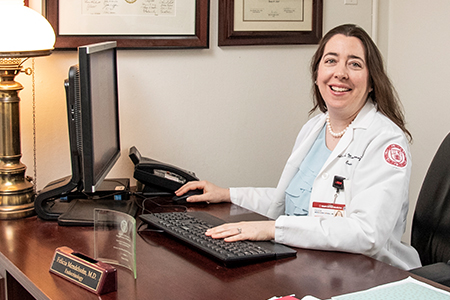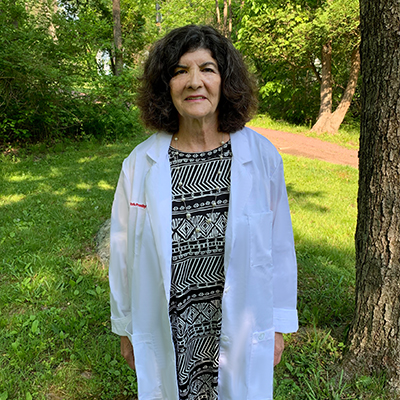COVID-19 and Diabetes: Importance of Glycemic Management
Dr. Felicia A. Mendelsohn Curanaj
“A large percentage of hospitalized patients with COVID-19 have diabetes. Many have hyperglycemia, increased insulin resistance, and even new presentations of diabetes,” says Felicia A. Mendelsohn Curanaj, MD, Assistant Professor of Clinical Medicine at Weill Cornell Medicine and Director of the Inpatient Glycemic Management Program at NewYork-Presbyterian/Weill Cornell Medical Center. “We also see diabetic ketoacidosis in patients with and without known pre-existing diabetes. With the concern that having diabetes could lead to a potentially worse outcome or more serious infection, we implemented initiatives to manage their glucose levels in order to try to improve outcomes.”
“Patients with COVID-19 are sicker and their diabetes is harder to manage,” says Jane Jeffrie Seley, DNP, MPH, MSN, GNP, BC-ADM, CDE, CDTC, FAAN, Clinical Assistant Professor of Medicine and Diabetes Nurse Practitioner at Weill Cornell Medicine. “Their insulin resistance is more severe and we often have to administer more aggressive therapy than we might have used before. To compound that, many patients go home from the hospital on a much more complex regimen than they previously followed.”
Dr. Jane Jeffrie Seley
Dr. Seley cites a patient admitted with COVID-19 who had been on one oral medication, never checked her blood glucose at home, and had target A1c levels. “With COVID-19, she required two different kinds of insulin in substantial doses, her A1c numbers were double digits, and we didn’t know what diabetes management plan would be best for her long term,” she says. “The patient had to make several lifestyle changes very quickly in order to accommodate a much more intensive regimen than she needed prior to her admission and diagnosis of COVID-19.”
“At the same time, we were seeing another phenomenon in which a patient is very insulin-resistant, requires a lot of medication, then the insulin resistance dissipates quickly, and suddenly the patient doesn’t need all that therapy and has very low blood glucose levels,” adds Dr. Seley. “Colleagues at other institutions found that to be the case too.”
Modifying Treatment Regimens
“We partnered with our endocrinology fellows, pharmacy, nutrition, medicine, and nursing to develop new protocols for patients with diabetes who are COVID positive and very sick,” says Dr. Seley. Among the new guidelines Dr. Mendelsohn Curanaj, Dr. Seley, and the team created was the management of diabetic ketoacidosis (DKA) with subcutaneous insulin for patients with mild-to-moderate DKA.
“Often when patients are admitted with DKA, the initial plan is to put them on an IV insulin infusion with hourly blood glucose checks,” says Dr. Mendelsohn Curanaj. “The concern, of course, is that this would require the nurse to go into the patient’s room every hour and perform a fingerstick glucose. This also would entail the nurse putting on new personal protective equipment every hour. So, for patients with more mild-to-moderate DKA we recommended subcutaneous insulin every two hours in order to properly manage the glucose levels and reduce the amount of exposure to COVID-19 for the nursing staff.”
“A large percentage of hospitalized patients with COVID-19 have hyperglycemia, increased insulin resistance, and even new presentations of diabetes.” — Dr. Felicia A. Mendelsohn Curanaj
The team also created a guideline for the use of sitagliptin instead of bolus insulin for meal coverage in patients with type 2 diabetes who are either well managed at home on oral agents, or by basal insulin and oral agents along with lifestyle changes. “With this guideline based on certain requirements, we advised the use of sitagliptin along with one injection per day of basal insulin. This allows the glucose monitoring to be reduced to twice daily – fasting and at bedtime,” explains Dr. Mendelsohn Curanaj.
Bundling of Care
Dr. Mendelsohn Curanaj and Dr. Seley also worked with nursing leadership to implement novel methods of care delivery to decrease face-to-face time with nurses and patients and to minimize the use of PPE. “One nursing recommendation was to bundle care, checking the blood glucose, administering the insulin, and serving the meal within a single visit,” says Dr. Seley. “Performing all three tasks at one time is optimal for the patient as well as the nurse.”
According to Dr. Mendelsohn Curanaj, insulin requirements were eventually reduced in some patients who had been hospitalized for more than one month. “As their infection was resolving, we were able to titrate down their diabetes therapy over time,” she says. “For patients discharged sooner because they are more stable, it’s very important to make sure they receive close outpatient follow-up as they recover at home. There is some literature starting to come out that by achieving glycemic targets, you can improve outcomes for patients with COVID-19. So, I think it’s definitely important while patients are in the hospital, especially those with known diabetes, to focus on their glycemic management to make sure that it is as close to glycemic goals as possible.”





